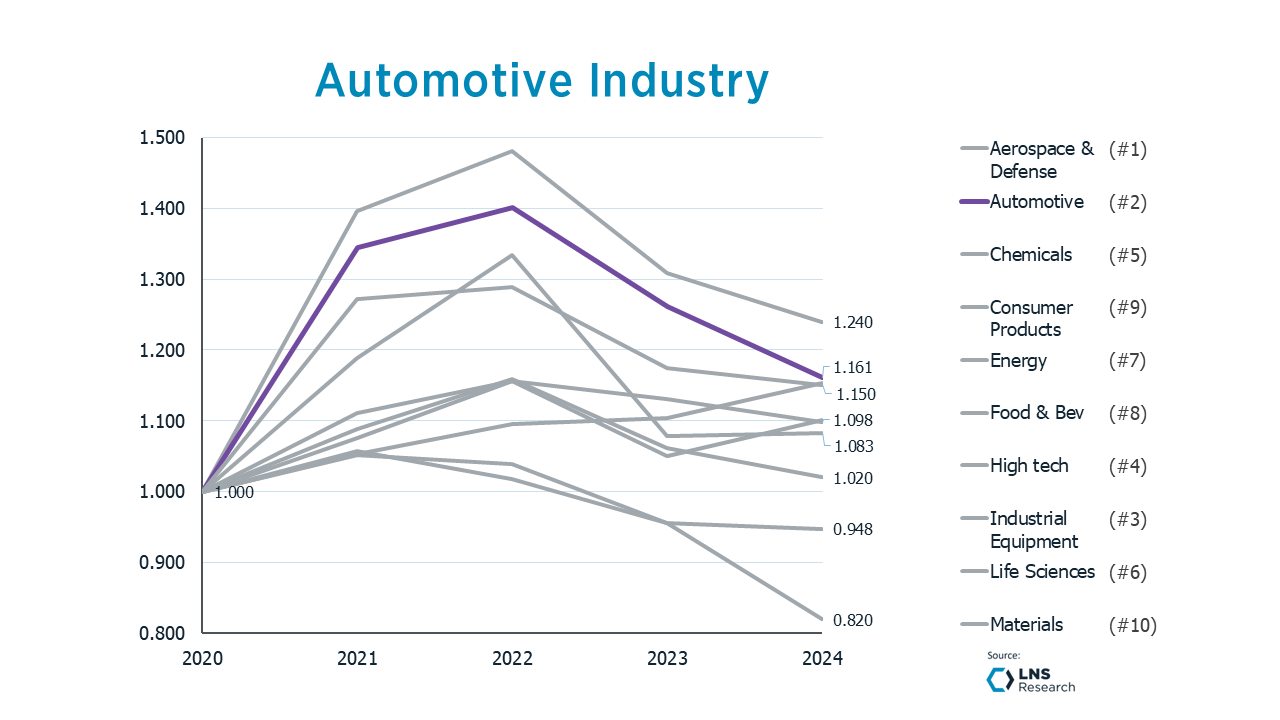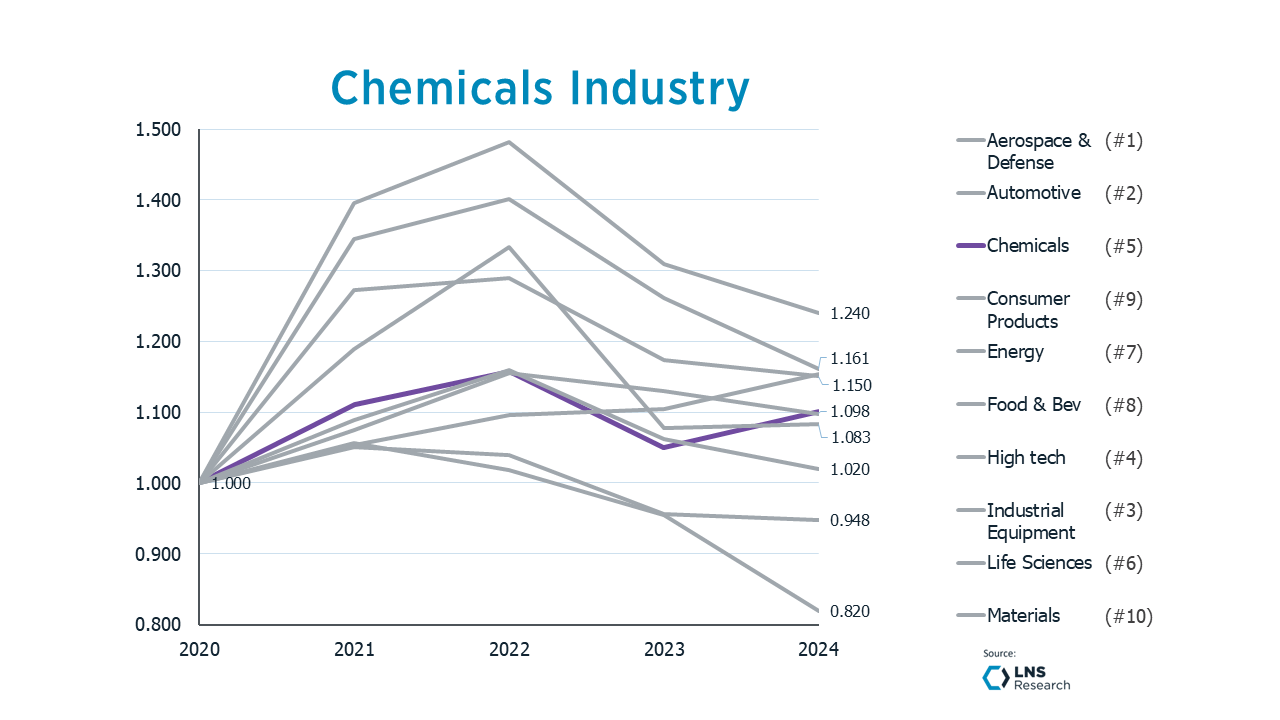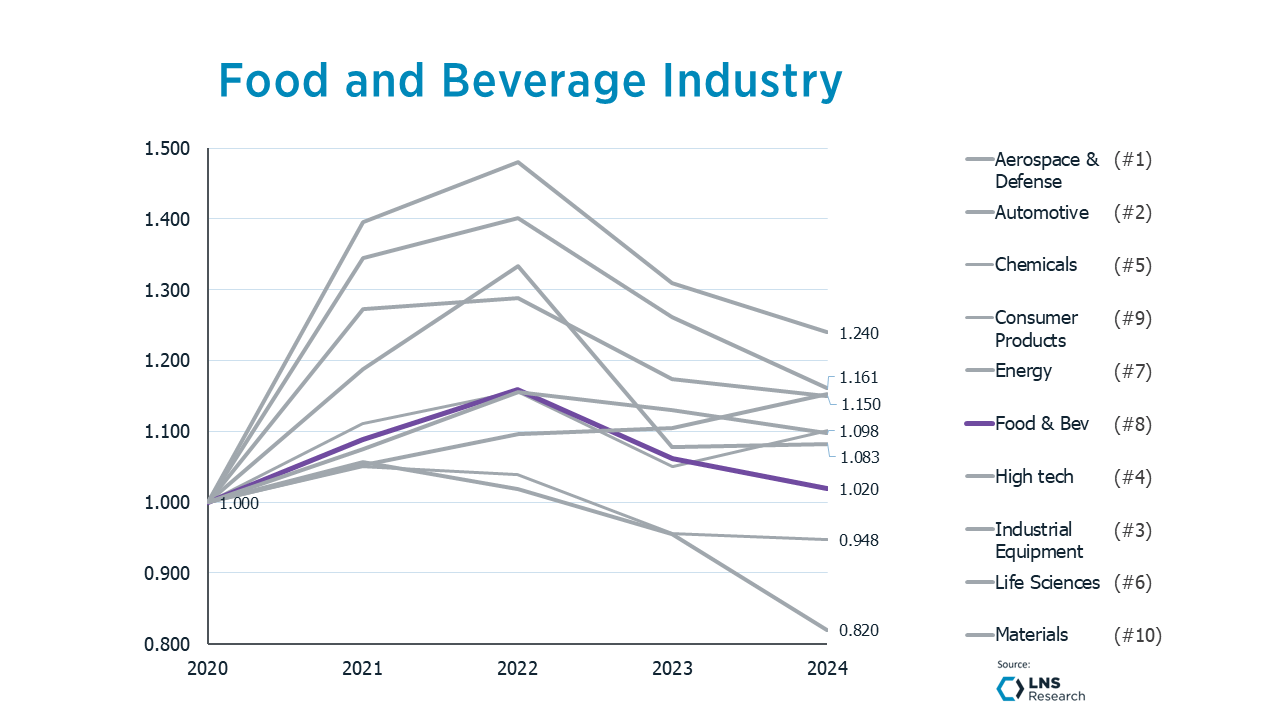INDUSTRIES
Aerospace & Defense .svg)
Aerospace and Defense companies have historically struggled with industrial productivity. Cost-plus government contracts, manual processes, disconnects between engineering and operations, complex products, and a move to lifecycle services have all hampered performance.
But since 2020, no industry has performed better. Investments in digital twin, digital thread, and new operating models have enabled the industry to thrive, while being supported by macroeconomic tailwinds – exemplified by the World’s Most Productive Companies like GE Aerospace and Rolls-Royce PLC.


Industry Details
The Aerospace and Defense companies were grouped based on production focus, ranging from OEM providers (aircraft, shipbuilding) to suppliers of control systems, engines, and defense systems. We also accounted for certain diversified companies with footprints in multiple categories: Aircraft; Defense and military systems (armored vehicles, ships and boats, weapon systems, etc.); and Aircraft parts (control systems, engines, and components, etc.). Thirty-three companies are included in the A&D Index.
Aerospace & Defense Peer Groups
 |
 |
 |
 |
Key Industry Productivity Statistics: Aerospace & Defense
- The Aerospace and Defense Industrial Productivity trendline is a flatter curve than the IPI curve overall. The industry had “only” a 3.2% decline in productivity over the last 20 years.
- The industry saw 47.5% productivity growth from 2020 to 2022 as the airline industry rebounded from COVID and a Boeing production shutdown.
- The industry has regressed to stagnation and decline with a 16.7% productivity drop from 2022 to 2024.
- Last year, the industry had an average 5.6% productivity decline.
- Every A&D company had negative productivity growth from 2022 to 2024 (though 2021 was a strong year generally).
- 28 of 33 companies regressed in productivity last year.
Automotive .svg)
Automotive companies have historically been top industrial productivity performers. A long tradition of pioneering new manufacturing production processes and an early embrace of Lean manufacturing operating models – based on the principles of the Toyota Production System – have all yielded significant results.
Since 2020, that success continued as the #2 most productive industry, especially as leaders brought together Industry 4.0 and lean together in a transformation approach exemplified by companies like Kia and Mercedes-Benz. Since 2022, however, demand reductions and EV demand oscillations have weighed on productivity growth.

Industry Details
The Automotive sector was split by vehicle types (electric, gas-powered, heavy duty) and a wide range of suppliers differentiated by components, like powertrains, interiors, exteriors, electronics, and tires: Electric vehicles; Gas-powered vehicles; Heavy-duty and motorcycles; Aftermarket parts; Electrical and electronics components; Exterior and chassis components; Interiors; Powertrain and transmission; and Tires. Sixty-seven companies were included in the Automotive Index.
Automotive Peer Groups

|

|

|

|

|

|

|

|
Key Industry Productivity Statistics: Automotive
- The Automotive Industry was one of three industries (along with High Tech and F&B) that demonstrated productivity growth over the last 20 years. The industry grew productivity by 22.8% from 2004 to 2024. In fact, it is fair to say that Automotive and High-tech hid the real scale of the Productivity Crisis by offsetting much of the decline across the other industries.
- Like other industries, the Automotive industry experienced a strong COVID productivity bounce, increasing by 42.6% from 2020 to 2022.
- The Automotive industry began to decline from that COVID high, with a 14.4% productivity decline from 2022 to 2024.
- In 2024, the Automotive industry regressed, along with seven other industries, recording a 4.1% decline in productivity.
- 94% of Automotive companies experienced a decline in productivity over the last three years.
- 63 of 67 companies had negative productivity growth last year.
Chemicals .svg)
The Chemicals industry has experienced one of the most volatile productivity cycles of the last two decades. The sector’s long-term trajectory shows pronounced swings tied to commodity and energy cycles, regional capacity expansions, and portfolio realignment. Since 2020, the COVID rebound aided by strong prices, mix optimization, and volume was followed by two years of regression when energy, labor, and input costs normalized. After peaking in 2022, the general lack of new capital investment in the US and Europe coupled with a developing over-capacity in China left the Chemical industry trailing the all-industry average for the first time since 2017 as productivity declined through 2024.
Companies within the industry are among the most structurally complex, yet many still define Operational Excellence narrowly, focusing largely on safety and cost. While laggards have slipped as inflation, energy volatility, and compliance costs eroded productivity, the World’s Most Productive Companies (WMPC) within the Chemicals industry have leveraged operating models that embed reliability, quality, and energy performance into daily execution rather than focusing on episodic improvement programs, with companies like Linde and Ecolab having doubled down on digitalized decision-making across the value chain.

Industry Details
Chemicals were organized into peer groups classified by production focus, specialty orientation, and integration depth: Diversified Majors, Fertilizers & Nutrients, Industrial Gas, Inorganic & Performance Materials, Life Sciences & Sustainability, Organic & Advanced Materials, Paint and Coating, and Polymers & Petrochemicals. Forty-two companies were included in the Chemicals Index.
Chemicals Peer Groups

|

|

|

|

|

|

|
Key Industry Productivity Statistics: Chemicals
- Over the last 20 years, Chemicals productivity declined by 11.1%, making it one of the weakest long-term performers among major industries, which experienced a 16.7% productivity growth on average.
- The Chemical Industry Productivity trendline is a negative curve compared to the IPI curve overall. The industry had an 11.1% decline in productivity over the last 20 years.
- The Chemical industry realized a COVID productivity bump with 28.6% productivity growth from 2020 to 2022.
- Like most other industries, the Chemical Industry regressed from 2022 to 2024 with a negative 12.9% productivity growth.
- Last year, the industry “only” had an average 1.4% productivity decline compared to the 2.9% average across all industries.
- Every Chemical company has had negative productivity growth over the last six years.
- 62% of Chemical companies saw productivity growth over the last three years.
- 24 of 42 companies experienced negative productivity growth last year.

Consumer Products companies have traditionally been in the middle of the pack for industrial productivity growth but have struggled since 2020, with the second worst performance of any industry.
Typically, more focused on brands and supply chains than manufacturing, the industry has seen an increase in outsourced manufacturing over the past decades, but has not reaped the same productivity benefits as Food & Beverage and High-tech.
Further, some of the outdoor and alcohol brand companies that saw significant benefits coming out of COVID-19 have not been able to sustain the gains post-2022.
Finally, some high-profile, high-margin companies like P&G are not just brand companies but have invested heavily in R&D and innovated new operating models like the Integrated Work Systems (IWS). However, others in the industry that have adopted IWS have not been as successful as companies in other industries that have been more likely to adopt TPS principles.
For future success, look toward European Pathfinders forging their own way through an integration of new operating models and Industry 4.0 technologies like stalwarts Beiersdorf and Reckitt.
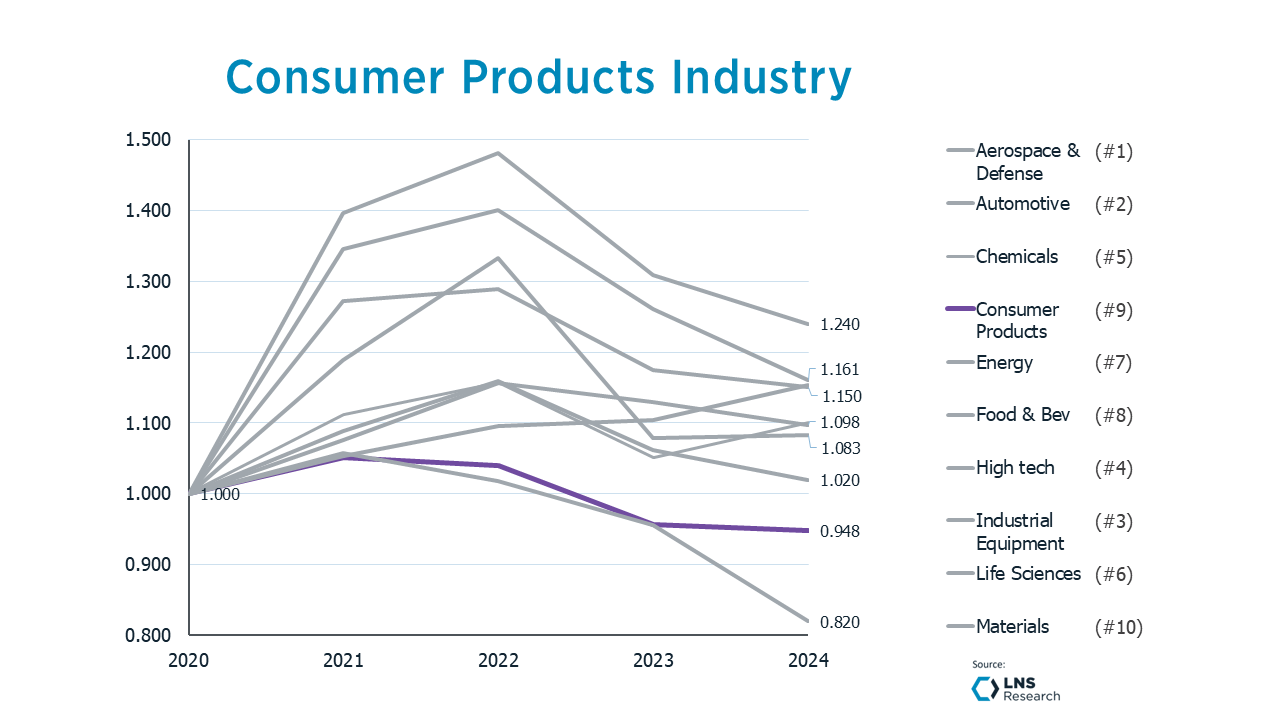

Industry Details
The Consumer Products sector is an eclectic assortment of peer groups covering a wide range of different products. LNS Research tracks productivity performance by peer group, which consists of companies within an industry that generally compete for the same business in the same markets. In Consumer Products, we study eight peer groups and have seen productivity performance vary widely across them: Beauty & Cosmetics, Home & Personal Care, Home & Office Furniture, Home Appliances & Consumer Electronics, Luxury Goods, Recreation & Sporting Goods, Tobacco, and Household Finishes, Tools & Power Equipment. Sixty-nine companies were included in the Consumer Product Index.
Consumer Products Peer Groups

|

|

|

|

|
Key Industry Productivity Statistics: Consumer Products
- The Consumer Products Industry productivity trendline is a flatter curve than the IPI curve overall. The Industry had a 5.2% decline in productivity over the last six years. The eclectic nature of this Industry made wide variation in productivity growth between companies almost inevitable.
- The Consumer Products Industry realized a smaller-than-average COVID productivity bump, with 19.1% productivity growth from 2020 to 2022. This varied greatly by peer group within the Industry.
- Like most other industries, the Consumer Products Industry regressed from 2022 to 2024 with negative 8.4% productivity growth (though 2021 was a strong year generally and in some peer groups specifically). Last year, the Industry reverted to the mean and recorded a 2.6% productivity decline.
- 68% of Consumer Products companies regressed in productivity over the last two years.
- 47 of 69 Consumer Products companies in the Index had negative productivity growth last year.
Energy .svg)
Energy companies have been among the worst performers in industrial productivity over the past two decades, significantly contributing to the decline in the overall index. Limited capital investment in the U.S. and Europe, difficulty attracting new talent, and a focus on short-term shareholder returns over long-term value creation have all served as headwinds.
While performance since 2020 has improved, mirroring productivity gains across all industries, the sector’s continued emphasis on asset preservation and compliance-driven programs rather than digital infrastructure and operational modernization has constrained growth. Industry leaders such as Petrobras, Chevron, and Valero Energy are breaking the pattern by integrating predictive analytics, digitizing operational excellence, and balancing technology investments (e.g., digital twins and APC) with strategic sustainability initiatives (e.g., decarbonization) to drive cross-value chain visibility and productivity gains.

Industry Details
The Energy sector was divided by oil and gas operations and electric utilities, reflecting both traditional and emerging sources of power. Peer groups included upstream, midstream, downstream, and vertically integrated oil and gas producers, as well as independent power producers and vertically integrated utilities managing transmission and distribution.
Each peer group represents a unique part of the energy value chain, from resource extraction and refining to power generation and grid distribution, with differing exposure to market volatility, regulatory pressure, and decarbonization trends. As such, how peer groups mix significantly matters due to segments having different cyclicality and labor intensity profiles (e.g., downstream is high margin and utilization-driven, while T&D is service and field-work intensive). Fifty-six companies are included in the Energy Index.
Energy Peer Groups

|

|
Key Industry Productivity Statistics: Energy
- The Energy industry has been by far the worst performer when compared to other industries and is a clear drag on the overall Index. The industry delivered 59.2% negative productivity growth from 2004 to 2024. The vertical is the prototypical example of being profitable and unproductive.
- Echoing the overall Index, Productivity declines in the Energy industry began to flatten from 2016 to 2020, and in fact showed a significant 33.3% Productivity growth from 2020 to 2022 (the COVID years).
- Like most other industries, the Energy Industry regressed from 2022 to 2024 with a negative 18.8% Productivity growth (though 2021 was a strong year generally).
- Last year, the Energy Industry was one of only two industries (along with Materials) that experienced productivity growth. The industry delivered 1.1% year-over-year productivity growth.
- 68% of companies had negative productivity growth over the last six years.
- 24 of 56 companies had positive productivity growth last year.
Food & Beverage .svg)
Food and Beverage companies are one of three industries that have actually grown industrial productivity over the past 20 years. The industry is notoriously low-margin and labor-intensive. It has a significant historical focus on operational excellence, which has paid dividends through approaches like TPM or WCM and metrics like OEE. More recently, because of these factors, the industry has been a leader in adopting Connected Frontline Workforce applications and Smart Manufacturing approaches.
The Food and Beverage industry has also adopted an outsourced manufacturing approach through co-packers, which drives suppliers to differentiate themselves in their ability to drive innovation through NPI, sustainable cost savings, and productivity improvements.
LNS Research expects this industry to be a continued source of innovation and performance improvement, led by the World’s Most Productive Companies like Remy Cointreau and John B Sanfilippo & Son Inc.

Industry Details
Categories in the Food and Beverage industry were based on product type, with a split between alcoholic and non-alcoholic beverages, agricultural products, and a range of packaged foods, including snacks, dairy products, and confectionery. Several of the packaged food companies had different levels of vertical integration, which was accounted for, in addition to product type mixes: Agricultural commodities and products, beverages, ingredients and flavors, and packaged (cereal, confectionery, dairy, etc.). Sixty-two companies are included in the Food and Beverage Index.
Food & Beverage Peer Groups

|

|

|

|

|
Key Industry Productivity Statistics: Food & Beverage
- The Food and Beverage Industry productivity trendline has the same shape as the IPI and most industries, with improved performance coming out of the COVID years and regressing over the last two years. The industry had a 12.6% growth in productivity over the last 20 years.
- The Food and Beverage Industry realized a notable COVID productivity bump, with 33% productivity growth from 2020 to 2022. The bump was large, but it was well below that of other industries.
- Like most other industries, the Food & Beverage Industry regressed from 2022 to 2024 with negative 21.4% productivity growth (though 2021 was a strong year generally).
- Last year, the Food and Beverage Industry regressed, recording a 10.9% productivity decline.
- 56% of companies had negative productivity growth over the last six years.
- 50 of 62 companies had negative productivity growth last year.
High-tech .svg)
High-tech companies are industrial productivity growth machines; no industry has done better over the past 20 years.
Having moved a decade (or more) beyond outsourced, low-cost-labor arbitrage models, high-tech companies are investing more capital in manufacturing capabilities than any other industry. These investments are highly automated, leveraging Industrial AI capabilities and tight integration between engineering, manufacturing, and supply chain functions.
Top performers include EMS vendors such as Sanmina, Benchmark Electronics, and Kimball Electronics, along with semiconductor companies like TSMC and GlobalFoundries, as well as equipment manufacturers like Rewitty and Canon.
The industry's only shortcoming may be that many EMS companies lack competitive differentiation; however, not enough companies look to high-tech manufacturing as a source of inspiration and best practices.
In fact, the contract model represented by the EMS space, as well as the two World's Most Productive Companies in Semiconductor (Global Foundries and TSMC), reflect a possible playbook for the future of profitable manufacturing around investment in process innovation, efficient supply chains, human capital development, and intense focus on efficiency and productivity.
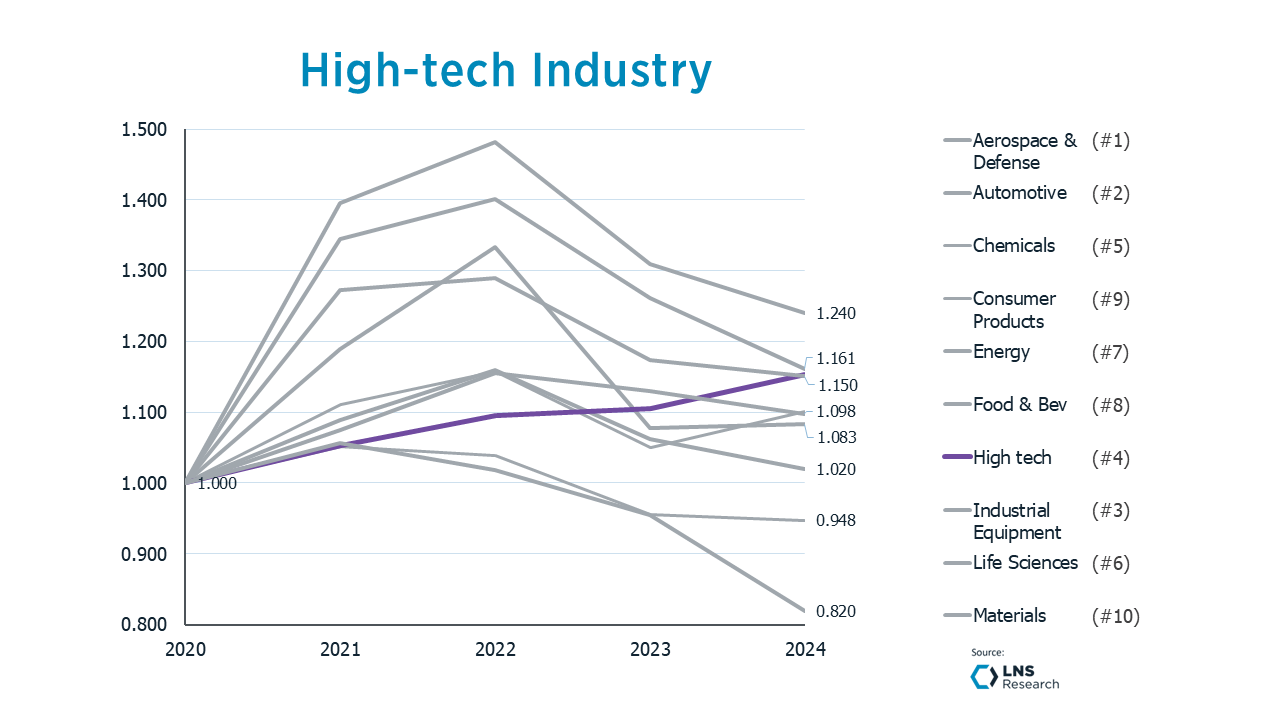

Industry Details
The sub-industries in High-tech were divided between equipment manufacturing, including computing and connectivity equipment, and component production (solar panels). We also accounted for differences between semiconductor fabs and electronic manufacturing services (EMS) companies, including connectivity equipment, personal computing equipment, semiconductor chips, printed circuit board assembly, and Solar panels. Twenty-eight companies were included in the High-tech Index.
High-tech Peer Groups
|

|

|

|

|
Key Industry Productivity Statistics: High-tech
- The High-tech Industry productivity trendline is a steeper, upward curve compared to the general IPI curve. The Industry had a 51.7% increase in productivity over the last 20 years.
- The Industry saw 31.8% productivity growth from 2020 to 2024, pulled along by improved productivity in the EMS peer group.
- Last year, the Industry had an average 4.8% productivity improvement.
- Most High-Tech peer group companies had negative productivity growth from 2022 to 2024 (though 2021 was a strong year generally).
- 31 of 60 companies regressed in productivity last year.
Industrial Equipment .svg)
The Industrial Equipment sector is the largest in this study, consisting of 136 companies generating about $1.86 trillion in annual revenue. These firms produce industrial machinery, equipment, components, and other critical systems essential to several sectors across manufacturing, construction, energy, utility, infrastructure, and agriculture.
Productivity growth has been moderate in the Industrial Equipment industry, tracking broader macro trends — a sharp dip in 2008–2010, stagnation through the 2010s, and a post-COVID rebound that lifted 2024 productivity to 0.948, ranking fourth overall among the ten industries. Most companies in this industry are product-centric, earning revenue from equipment sales, though some lean more toward service-based models emphasizing maintenance, support, and digital solutions.
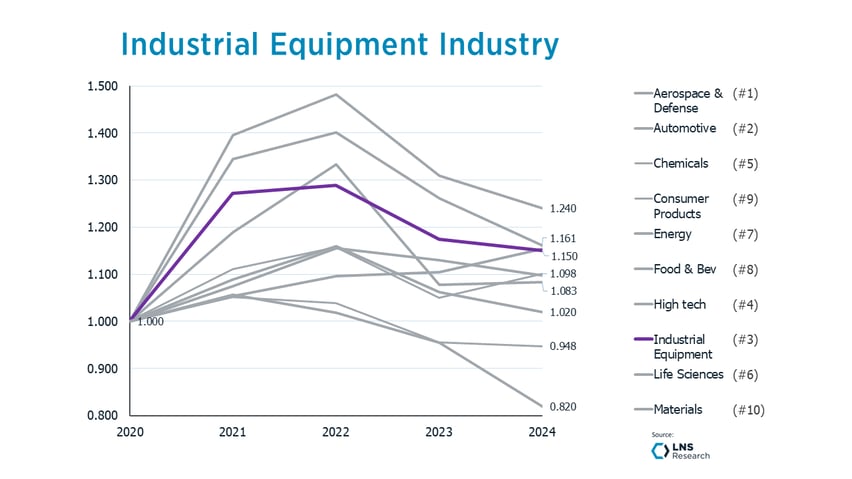
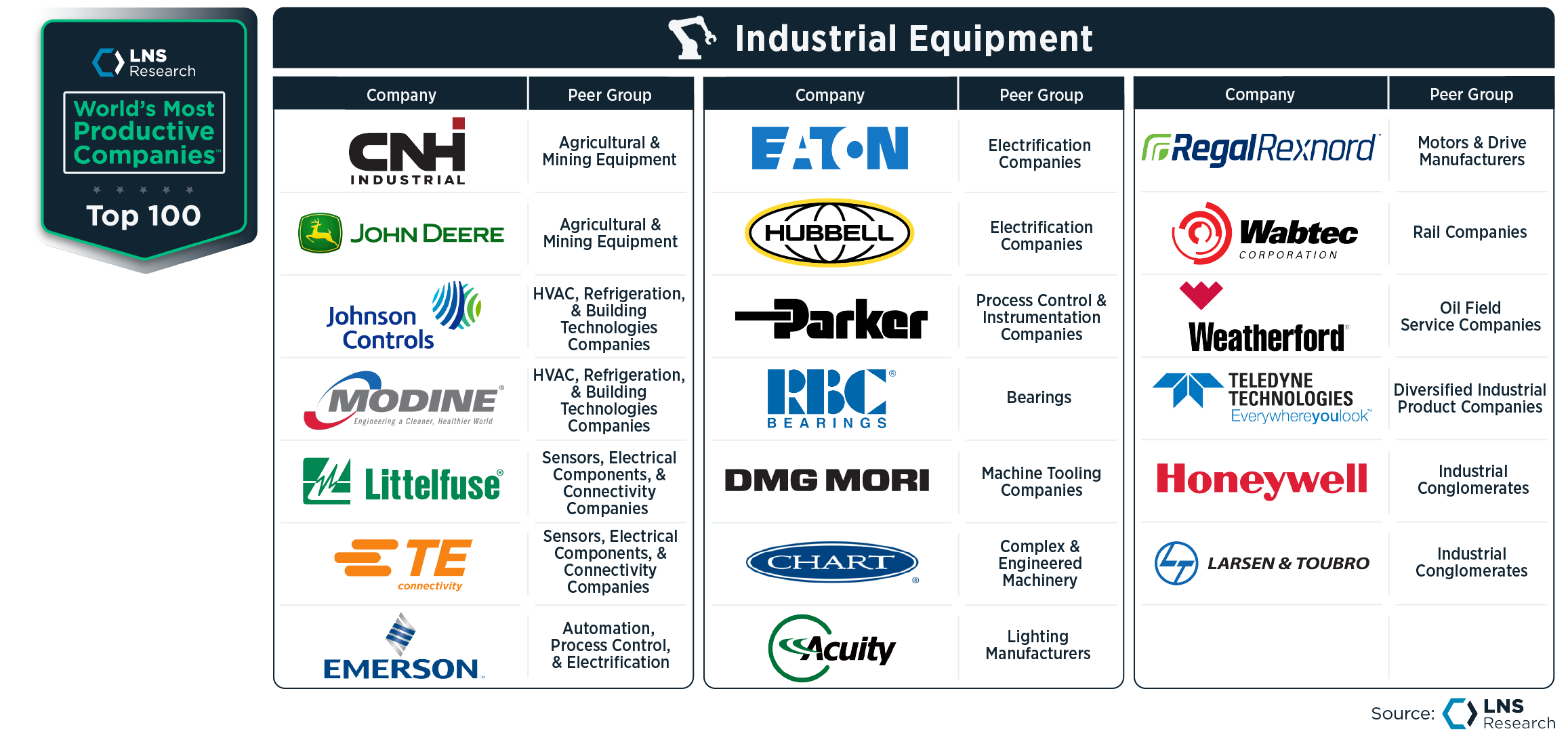
Industry Details
The Industrial Equipment industry encompasses a diverse range of manufacturers organized into 21 peer groups, covering everything from large-scale machinery—such as agricultural, mining, construction, and semiconductor equipment—to specialized industrial components, including bearings, automation systems, lighting, and sensors. It also includes diversified product companies and some of the world’s largest industrial conglomerates, reflecting the sector’s broad scope and critical role across nearly every area of the industrial sector.
Industrial Equipment Peer Groups

|

|

|

|

|

|

|

|

|

|

|

|

|

|

|
Key Industry Productivity Statistics: Industrial Equipment
- The Industrial Equipment Industry productivity trendline is a flatter curve than the IPI curve overall. The Industry had a 19.1% increase in productivity over the last 20 years.
- The Industrial Equipment Industry realized a notable COVID productivity bump, with 43.6% productivity growth from 2020 to 2022.
- Like most other industries, the Industrial Equipment Industry regressed from 2022 to 2024 with a negative 15.6% productivity growth (though 2021 was a strong year generally).
- Last year, the Industry recorded 4.9% negative productivity growth.
- 90% of Industrial Equipment companies regressed in productivity over the last three years.
Life Sciences .svg)
Life Sciences companies have historically struggled with industrial productivity growth. They rely on above-average operating margins and are more concerned with R&D success and regulatory compliance. This has resulted in the second-worst performance among all industries over the past twenty years.
However, since 2020, the industry has performed better, ranking in the middle of the pack and increasing productivity by approximately 10%. COVID-19 revealed to many life sciences companies the benefits and possibilities of moving faster and delivering more through improved manufacturing capabilities.
This has resulted in a generational shift in the deployment of new capital expenditures, in the form of billion-dollar-plus sites, which bring new technology and approaches that extend across the entire value chain. These tie together R&D through the patient experience, embedding quality and compliance, and enable novel approaches at scale, like cell gene therapy and other personalized medicines.
Look to Life Sciences companies to continue their improvements, with some even moving into leadership positions, particularly for Pathfinder companies such as Danaher, Merck, Lilly, and GE Healthcare.
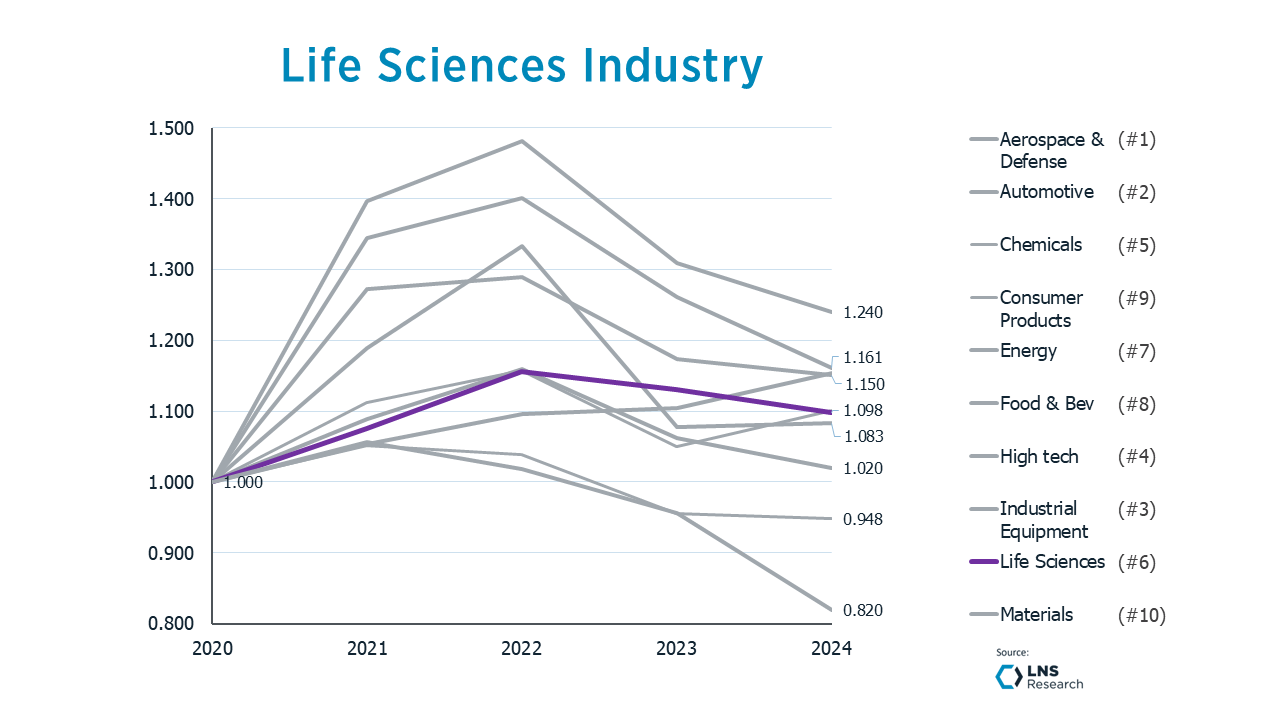

Key Industry Details
The Life Sciences industry was split by the type of health and medical focus, including biotech, pharmaceuticals, medical devices, and contract manufacturers. The pharmaceutical industry accounts for pricing differences between specialized pharma companies and the larger, more diversified ones, with scope to further differentiate based on the type of drugs and diseases targeted: Biotech, CDMO and distributors, Medical devices, Pharmaceuticals (diversified across disease areas), and Pharmaceuticals (specialized disease areas). Seventy companies were included in the Life Sciences Index.
Life Sciences Peer Groups

|

|

|

|

|
Key Industry Productivity Statistics: Life Sciences
- We often think of the Life Sciences Industry as on the leading edge. Yet, the Industry has been one of the worst productivity performers when compared to other industries (along with the Energy Industry). The Industry delivered only 11.25% productivity growth from 2005 to 2024. The highly regulated, validation-constrained nature of manufacturing in Life Sciences may be core to the Industry’s productivity crisis.
- Like the overall Index and most other industries, productivity declines flattened in Life Sciences from 2016 to 2020. Life Sciences saw a notable COVID bounce, growing productivity 53.9% from 2020 to 2022.
- Like most other industries, the Life Sciences Industry regressed from 2022 to 2024 with negative 10.67% productivity growth (though 2021 was a strong year generally).
- Last year, the Industry recorded 1.84% negative productivity growth.
- 70% of Life Sciences companies had negative productivity growth from 2021 to 2024 (though 2021 was a strong year).
- 49 of 70 Life Sciences companies had negative productivity growth last year.
Materials .svg)
Materials companies have historically struggled with growing industrial productivity. From 2004 to 2024, they delivered the third-worst performance, accounting for a 22% productivity loss.
Unfortunately, the story is even worse when considering just the post-COVID-19 boom, with materials being the worst-performing industry.
Material companies suffer from many of the same challenges as other process industries: a lack of capital investment, workforce challenges, and a relative lack of investment in operational excellence and operating models. They also face unique challenges, including a boom-and-bust cycle highly dependent on volatile commodity prices and a recent rash of high-profile digital transformation initiatives that failed to deliver results.
However, there are bright spots in the industry, especially in some building products, packaging, and metals companies that are taking on business-led transformations, embracing new operating models, advanced analytics, and virtual operations center approaches.
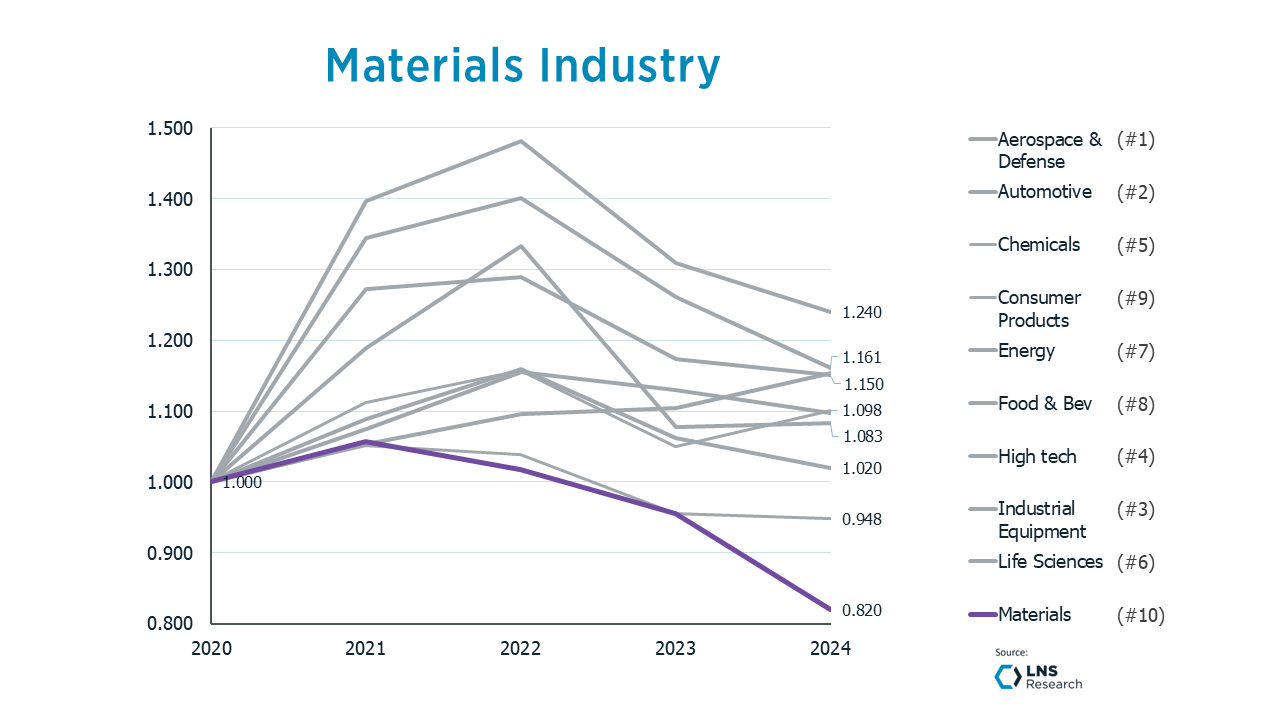

Industry Details
The diverse Materials industry includes a range of companies, from those that refine, process, and mine metals, to those that mine minerals, accounting for price changes across specific metals such as aluminum, Copper, Gold, and steel. Additionally, the industry also includes several types of building material companies, packaging, and specialty materials that account for price changes based on their products: Building materials (aggregates and construction, home improvement, roofing, etc.); Metals and mining (Aluminum, Copper, Gold, etc.); Packaging (glass, metal, plastic, etc.); and Specialty materials. Sixty-one companies were included in the Materials Index.
Materials Peer Groups

|

|

|

|

|

|

|

|
Key Industry Productivity Statistics: Materials
- The Materials Industry productivity trendline is a negative curve compared to the IPI curve overall. The Industry had a 22.6% decline in productivity over the last 20 years.
- The Materials Industry experienced one of the most muted COVID productivity bumps, lasting only one year. Its productivity increased 5.7% from 2020 to 2021.
- The Materials Industry regressed significantly from 2021 to 2024 with negative 22.4% productivity growth (though 2021 was a strong year generally).
- Last year, the Industry had one of the worst years recorded, at 14.1% negative productivity growth.
- 46% of Materials companies regressed in productivity over the last three years. This was the second-lowest percentage across all industries, behind only High-Tech.
- 24 of 61 Materials companies in the Index had negative productivity growth last year.
How to Become a World's Most Productive Company
For operational executives interested in understanding what it takes to become a Productivity Pathfinder, LNS Research offers the data, benchmarks, and strategic insights to guide your journey. Schedule a Pathfinder benchmarking call today to explore how you can employ the best practices of Productivity Pathfinders.
Attend An
Event
Engage with senior operations leaders and explore strategies that drive real productivity gains
Read The
Report
Discover the data and insights behind the world’s most productive companies
Book a Pathfinder Benchmarking Call
Benchmark your performance and uncover your biggest opportunities for impact

